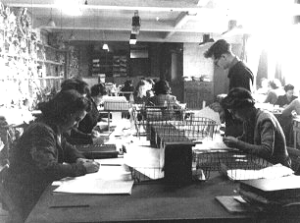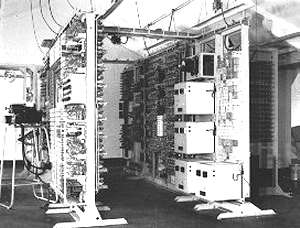Bletchley Park

Bought in 1882 by Sir Herbert Leon,
a wealthy stoke broker, expanded incrementally to its present size with
style changes about every 30ft round the outside. The right hand extension
was the last to be completed in the 1920's. Sir Herbert became an MP and
needed a larger dining room for enternainment so added one on with extra
bedrooms above. Sir Herbert died in 1927 and was succeeded by his wife
Fanny who was a great benefactrice to Bletchley. She died in 1937 and the
estate was then auctioned and purchased by a consortium head by Cpt Faulkner.
During World War I British code breaking was performed by Naval Intelligence
in "Room 40" at the Admiralty. In 1920 this function was transferred from
the Navy to the Foreign Office. At first, without an Enigma machine, there
wasn't much hope of breaking the German codes, and the British had almost
given up trying. In particular, the rotor wiring was unknown until, on
July 25, 1939, the Poles handed an Enigma replica over to the dumbfounded
British during a secret meeting near Pyry.
In August, codebreaking operations were physically moved to Bletchley Park
(known familiarly as "BP"), an estate 40 miles from London, although its
official designation was "Station X", as the tenth station. It was renamed
Government Code and Cypher School (GC&CS, often irreverently referred
to as the Golf, Cheese and Chess Society) under the direction of Naval
Commander Alastair Denniston. A number of "huts" (small frame houses) were
built to house the various divisions. Chess masters, mathematicians, professors
and linguists were recruited from all over Great Britain, most from Cambridge
University. Ian Fleming, one member of the team, went on to write the James
Bond novels. A coding machine was featured in the James Bond movie "From
Russia with Love." Not surprisingly, the brief view of the machine reveals
it is nothing like an Enigma, since in 1968 the Enigma was still under
wraps.
BP and Enigma
When Gordon Welchman reported to BP's Alastair Denniston he was assigned
to the man in charge of Enigma operations, Dillwyn "Dilly" Knox. Alan
Turing, a brilliant mathematician who developed the "Universal Turing
Machine," the conceptual forerunner of the modern digital computer, was
also working in the same department. Although Welchman was supposed to
be working on traffic analysis, he idly started to think about how Enigma
traffic might be decoded. From consideration of the doubly encoded "sub-keys"
used by the Germans (see Chapter I), he devised a method of eliminating
some of the many possible keys. A number of sheets were to be perforated
with holes at specified locations, and stacked. Light shining through the
holes in one or more locations could indicate possible keys. When he submitted
his idea to Knox, he was surprised to find that the method was already
in use! He had independently invented the Poles' Zygalski sheets, now known
as Jeffreys sheets, named after the man in charge of the operation.
The possible keys suggested by the Jeffreys sheets were then tested on
"bombes," machines descended from the Polish bomby. During the "phony war,"
with the French hunkered down on the Maginot line for seven months, BP
was starting to decode some German messages. When Hitler invaded Denmark
and Norway on April 9, 1940, much of the German traffic was being decoded.
The British codebreakers at Bletchley
Park received an Enigma machine and rotors I to V from the Polish Cipher
Bureau in August 1939. Marian Rejewski, an outstanding Polish cryptanalyst,
had reconstructed the wiring of rotors I to III at the end of 1932 using
mathematical techniques, and the wiring of rotors IV and V before the war
began. The British recovered rotors VI and VII from the crew of U-33 on
12 February 1940, while rotor VIII was captured in August 1940.
In May and June 1940, using cleartext and cipher text captured from Schiff
26, Hut 8 at Bletchley Park had solved some April naval Enigma traffic
with the aid of the first bombe (a high speed key-finding aid). That bombe,
which was Alan Turing's brainchild, was much slower than the bombes with
the 'diagonal board' invented by Gordon Welchman. The improved bombe, with
the board, entered service in mid-August.

On average more than 3,000 coded messages
arrived at Bletchley Park each day from the 'Y' Stations. Messages were
taken to different 'Huts', depending on whether they had come from the
German army, air force, navy or another source. A message from a U-boat
would go
to Hut 8. Sometimes messages began
with the same words, such as a weather report. This gave clues (called
a CRIB) about how the rest of the message had been encoded. When the code-breakers
eventually worked out what the CRIB letters might be, they tested them
on the machine shown on the left, called a BOMBE. Bombes were huge, noisy
electro-mechanical machines which could check through combinations of letters
far quicker than a human being could. When the Bombe stopped, this meant
that the code-breakers' guesses were right. All that days U-boat messages
could then be decoded. The decoded messages were in German in blocks of
five letters. They had to be
carefully translated into English.
On the 9th of May, 1941, U-110 had
been about to attack an Allied convoy when it was forced to surface by
British ships protecting the convoy. The German crew surrendered. The British
were anxious to make sure that the Germans did not find out that U-110
and its codebooks had been captured. All the sailors who took part in the
operation were sworn to secrecy. If the Germans had found out, they would
almost certainly have changed their codes. This would have made the code-breakers'
job far more difficult - but by 1943 they had the help of Colossus - the
world's first programmable electronic digital computer.
Colossus was built for the code-breakers
at Bletchley Park by post office engineers in 1943. The computer was as
big as a room - 5
metres long, 3 metres deep and 2.5 metres high - and was made mainly from
parts used for post office telephone and telegraph systems. It was a development
from the mechanical Bombes. Colossus worked by 'reading', through a photoelectric
system, a teleprinter tape
containing the letters
of the coded message. It read 5,000 letters a second.
All possible combinations of the coded
message were checked with the cypher key generated by Colossus. A teleprinter
typed out the results of Colossus's search, revealing the settings which
had been used by the Germans to send their messages. Ten Colossus Mark
2s were eventually built. They cracked the Enigma codes and even more complicated
ones devised by the Germans on their 12 -rotor cipher machines. A complete
Mark 2 Colossus machine has recently been rebuilt and is on display at
Bletchley Park.
The information revealed by the code-breakers
at Bletchley Park was called ULTRA. ULTRA was so secret that only those
who needed to know about it - like the British Prime Minister, Winston
Churchill - were told of its existence.
Bletchley
Park today


